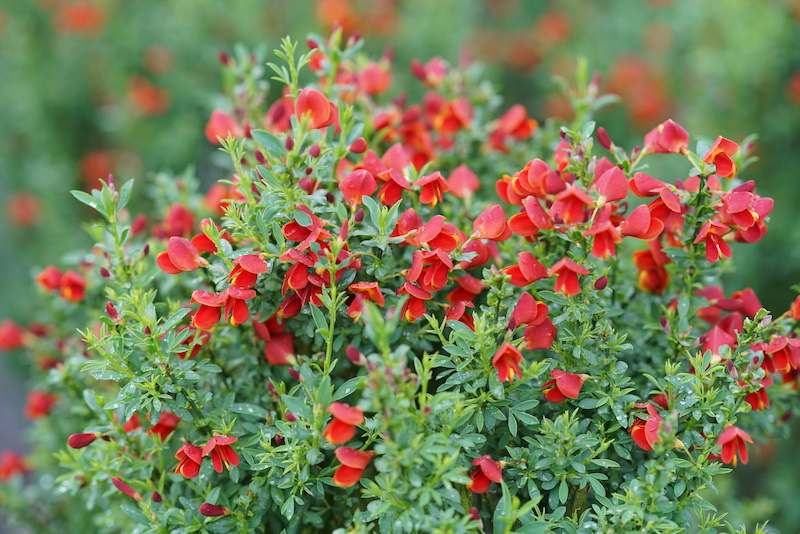Scotch broom is a hardy shrub that produces bright, golden yellow flowers in spring. However, without proper pruning, scotch broom can become leggy and unkempt. Learning how to correctly prune this plant will keep it looking tidy and promote vigorous growth.
When to Prune Scotch Broom
The best time to prune scotch broom is right after flowering in spring. Pruning at this time allows the shrub to recover through the summer and set strong buds for next year’s bloom.
Prune in late winter or early spring before new growth emerges. Avoid pruning late in spring after buds have formed
Tools Needed
Have these tools on hand before beginning
- Bypass pruners for small stems
- Loppers for thicker stems
- Pruning saw for old wood
- Disinfectant spray or wipes
Step 1: Remove Dead or Damaged Growth
Examine the shrub and cut out any
- Dead or dying stems
- Broken or split branches
- Crossing or rubbing branches
- Diseased sections showing signs of blight
Removing unhealthy wood first encourages vigorous regrowth.
Step 2: Thin Out Congested Areas
- Identify areas with many crisscrossing stems or branches emerging from one spot.
- Remove excess stems to open up the interior to sunlight and air flow.
- Leave 3-5 healthy, well-spaced stems.
Step 3: Cut Back Old Wood
- Locate older stems that are more than 2-3 years old.
- These will appear thicker and have darker bark.
- Cut these stems back to just above a lower side shoot.
This encourages new shoots to grow from the base.
Step 4: Shape and Contain Growth
- Identify 3-5 main branches to form the basic structure.
- Shorten long side shoots growing off the main branches to encourage bushier growth.
- Remove any shoots growing toward the interior.
Step 5: Remove Excess Flowering Stems
- Leave flowering stems about 6 inches apart to allow good air circulation.
- Remove small or weak looking flowering stems.
- This balances the plant’s energy between growth and blooming.
Step 6: Disinfect Tools
- Wipe down bypass pruners, loppers, and saws with disinfectant.
- This prevents transmitting diseases between plants.
Aftercare
- Water well after pruning to help recovery.
- Apply balanced fertilizer to encourage new growth.
- Monitor for suckers emerging from the root system and remove promptly.
How Often to Prune Scotch Broom
- Prune annually in early spring after flowering.
- You can prune lightly again in mid-summer if needed to control errant growth.
- Avoid frequent, heavy pruning which can stress the shrub.
Signs It’s Time for a Prune
- Leggy growth with bare lower branches.
- Dead wood accumulating inside and bottom of shrub.
- Shrub exceeds its allocated space.
- Flower production has declined.
Pruning scotch broom regularly in spring after flowering removes old wood, shapes growth, and encourages bountiful blooms. Follow this guide to learn when to prune, proper tools to use, and techniques for optimal pruning. Keeping broom plants well-pruned enhances their beauty in any landscape.
Growing broom: problem solving
Broom is generally problem-free.
Growing broom: jump links
Plant broom in any well drained soil, in a sunny spot. Broom does well on poor, stony or sandy soils and can also be planted on a slope. If you have alkaline soil, opt for Genista.
Red Broom Cytisus Praecox pruning video. How to in my walled garden English
FAQ
When should you prune broom?
How do you manage a Scotch broom?
Is it better to cut or pull scotch brooms?
How do you trim a broom?
When should a Scotch broom be pruned?
The first rule for pruning a scotch broom shrub involves timing. Although broken or diseased branches can be pruned off at any time of the year, size or shape pruning should only be undertaken in late spring, immediately after flowering. This rule about pruning a scotch broom shrub in springtime is critical if you want an attractive bush.
How do you prune a Scotch broom?
Here’s how it works. Scotch broom (Cystisus scoparius) is an attractive shrub that rises to about 10 feet (3 m.) high with an open, airy growth pattern. Despite the beauty of its bright yellow spring flowers, it can easily look disheveled if not pruned correctly. Pruning a scotch broom shrub must be done conservatively and at the correct season.
Can a Scotch broom be cut back?
If you cut these branches back severely, you are not likely to get a fuller plant; in fact, if you prune a scotch broom shrub in this manner, you may kill it. Note: Although broom plants produce attractive, sweet-pea like blooms, they have become highly invasive in many areas.
Do Scotch Brooms Bloom on old wood?
Because most varieties of Scotch Broom bloom on old wood, any pruning should be done just after flowering, whether to remove scraggly or damaged stems or for shaping and aesthetic purposes. Do this at the right time of the year to ensure masses of blooms the following season.
- The Ultimate Guide to Growing Strawberries in Raised Beds - August 8, 2025
- No-Dig Garden Beds: The Easiest Way to Grow a Beautiful Garden - August 6, 2025
- How to Protect and Preserve Wood for Raised Garden Beds - August 6, 2025

